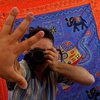Here comes the color. With a new round of assignments, dedicated to "human relationships", color images make their first appearance in the coursework. Here I would like to show a couple of frames from the shortest of the three sessions, which is about an exchange of views taking place at the University between some students and a faculty clergyman. In occasion of Women's Day 2009, an exhibit celebrating Palestinian women had been organized, so as to praise their role in the fabric of Palestinian society. As local people say, "men are the heads of the family... but women are the necks where these heads rest, deciding when and where the heads should turn..." Clever indeed. The exhibit included a corner with photos of women martyrs and, also, of some young ladies who participated to the armed struggle in the early years of the Second Intifada. Some of them lost their lives while taking others' lives. In the framework of the exhibit, this corner stood out as a very sensitive spot, at least to foreigner eyes. So, an intense debate quickly involved the American clergyman, the Italian photographer and the Palestinian students visiting that corner. In a genuinely passionate but far from overheated atmosphere, big questions were pondered, despite their destiny of remaining ultimately unsolved... Why are these women being remembered here? Is it to pay respect to their death, or rather to celebrate them as fighters for their country? Or more precisely, as they say in Arabic, as redeemers? What feeling do these images encourage? Sorrow? Admiration? Sadness? Courage? Hopelessness? For you, what is the meaning of keeping their memory alive? Are they presented as desperates, heroes, or... are they simply looking at you from the wall? Don't you think that Palestinian women who resist are those who remain steadfast and carry on with their lives, granting their living presence as a gift to their land? Questions like these are so incredibly complex, especially for those who are directly involved. Words and gestures tried to put together fragments of thoughts... eyes crossing and hands cutting through the air in the effort of making a point on the road to nowhere. But the real point, I guess, was the thinking itself, the questioning, the sharing of thoughts.
The debate lasted quite long, with alternating players all captured by the depth of the subject. The experience of martyrs inevitably exerts a large influence on Palestinian culture. And it seems that the existence of that corner had hardly surprised any Palestinian student, but when the sensitivity of a foreigner spurred their critical thinking, many showed some sort of unexpressable uneasiness. And an old, rancid, familiar frustration came up to the surface... "We hate this had to happen, we would never do it ourselves. It is so bad. But we can't forget them. We have to remember them. What can we do?..."
From a technical point of view, the 50mm lens worked perfectly for capturing subjects close to each other. Light was bad, and I had no option but raising ISO to 800. Most frames were taken at f8/30. I could have used a wider aperture, by one or two stops, and gained some speed. Finally, color does not add anything to these images. They probably work better in BW. Most of my situations are indoor these days, and I am looking forward to some nice, bright light.
Subscribe to:
Post Comments (Atom)



No comments:
Post a Comment